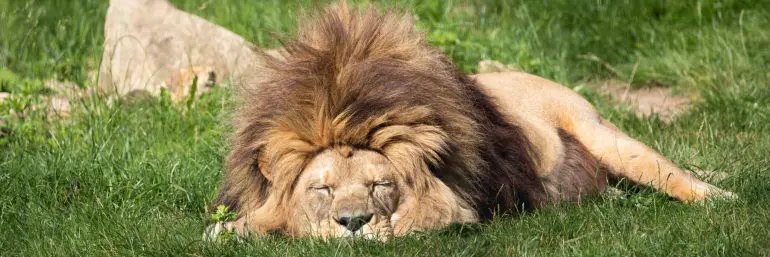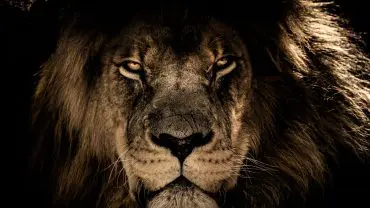Renowned for their males’ luxuriant manes, their social groupings and, of course, their roar, most people have a clearly defined image of lions. However, this homogenous view belies the genealogical, social and physical diversity of the species. In other words, there is more than one kind of lion. The question is, how many types are there?
How many types of lions are there

A male lion relaxes (Photo: Joanne Burrell via iStock)
It sounds like a simple question: How many different types of lions are there? In terms of lion species, this is indeed very straightforward. There is only one species of lion, namely Panthera leo (or P. leo). Panthera refers to the genus, which the lion shares with tigers, leopards, snow leopards and jaguars. This genus is part of the Felidae family, better known as cats.
Lion Types: The Scientific Answer

Beautiful young male African lion with a developing mane relaxing in the shade after a hunt in Sabi Sands Reserve in the Greater Kruger National Park of South Africa. He has a fresh scar from a recent hunt on his face. (Photo: AudreySmiths via iStock)
Things become more complex when considering the subspecies of Panthera leo. These classifications have been hotly debated over the years. From the mid-18th to mid-20th centuries, there were 26 recognised subspecies, down to about a dozen by the early 21st century. However, this classification was mostly done by physical characteristics, like mane and skin colours.
Since 2017, lion types have been classified by tracing the genetic lineages of lions in different locations. This is a process called phylogeographic analysis. As a result, there are now two recognised lion subspecies.
Two Lion Subspecies

Asiatic lion. A critically endangered species. (Photo: xtrekx via iStock)
The two lion subspecies are the Northern Lion (Panthera leo leo) and the Southern Lion (Panthera leo melanochaita).
The Northern Lion type covers what many call the ‘African Lion’, and covers lion populations in central and west Africa. This subspecies also included the Barbary lion, though sadly this is now extinct in the wild. The Northern Lion subspecies also includes Asiatic or Asian lions.
The Southern Lion, officially called the melanochaita subspecies, covers southern African lions, as well as those found in east Africa.
There is evidence of some overlap between the two current lion types. Research has suggested that lions found in central Africa have DNA from southern as well as northern lions. Current thinking is that the subspecies share a contact zone, probably Ethiopia.
The Complexity of Lion Types

Black Maned Lion, Lying and Looking Around (Photo: DavidPapenfus via iStock)
The question of the number of lion types is more complex than it initially seems. As set out above, by current scientific standards, there are two subspecies, namely the Northern and Southern kinds of lions.
On a geographical basis however, the two existing types often discussed are in fact the African Lion and the Asiatic Lion. However, as has been stated, this does not correspond to the established subspecies classification.
Lions Varieties Around The World
Generally, lions possess a long, powerful body that contrasts with their short legs, head and neck. In the cat family, they are second in size only to the tiger. Male and female lions look very different, a trait known as sexual dimorphism and one which no other cats display. A major aspect of this is the male’s prominent mane. Lions are also the most sociable cats, living in groups called prides.
Having made these generalisations, in practice lion varieties around the world can look and act very differently to each other. Even lions that share a genealogical lineage can be markedly different. So, even though they are both of the Panthera leo leo subspecies, African and Asian lions have noticeably different characteristics.
African Lions

Two big male African lions in early morning light, Kalahari desert, South Africa (Photo: EcoPic via iStock)
What is often referred to as the African Lion is the most iconic lion type and is what springs to mind when thinking of this big cat. Male African lions can grow to be between 2.6 and 3.3 metres, compared to females who reach a maximum of 2.4 to 2.7 metres. These measurements do not include the tail, which adds up to a metre to this size. They weigh up to 250kg for males and 180kg for females.
Asiatic Lions

Asiatic Lioness at Gir National Park, India (Photo: AriImages via iStock)
Found exclusively in India’s Gir National Park in the state of Gujarat, Asiatic lions tend to be smaller than their African counterparts.
The longest a male will grow, excluding tail, is 2.9 metres, weighing up to 190kg. They are also distinguished by having less luxuriant manes. Indeed the dark mane of Asian lions is short enough to expose their ears. They are also unique in having a fold of skin along the entire length of their belly.
When assessed in 2020, there were fewer than 700 Asiatic lions in existence. But their numbers are actually on the up, no doubt due to the high level of protection under which they now live.
White Lions

Majestic and rare African white lion (Photo: Shawn Levin via iStock)
While most lions are tawny brown in colour, there have been sightings of “white” lions. The white lion is not technically a type unto itself. Nor are they albinos. Rather, they are the result of a genetic mutation called leucism. This recessive gene has only been seen in South African lions and, even then, very rarely. It is said just 13 currently live in the wild, with a further 100 or so in captivity.
Other Lion Types

A Sleeping Barbary Lion (Photo: Cloudtail_the_Snow_Leopard via iStock)
Many lion varieties are now extinct. The American lion and Barbary lion are examples of this.
Finally, there are hybrid types bred in captivity. These include the liger and tigon. Both of these are a mix of lions and tigers, but the former is the offspring of a male lion and female tiger, reversed for the latter.
A Challenging Future

Pride of African lion resting in morning savannah in Kruger National park, South Africa (Photo: Eisenlohr via iStock)
Today, sadly, many different types of lions are extinct and those that survive are in steep decline, listed as Vulnerable on the International Union for Conservation of Nature Red List of Threatened Species.












